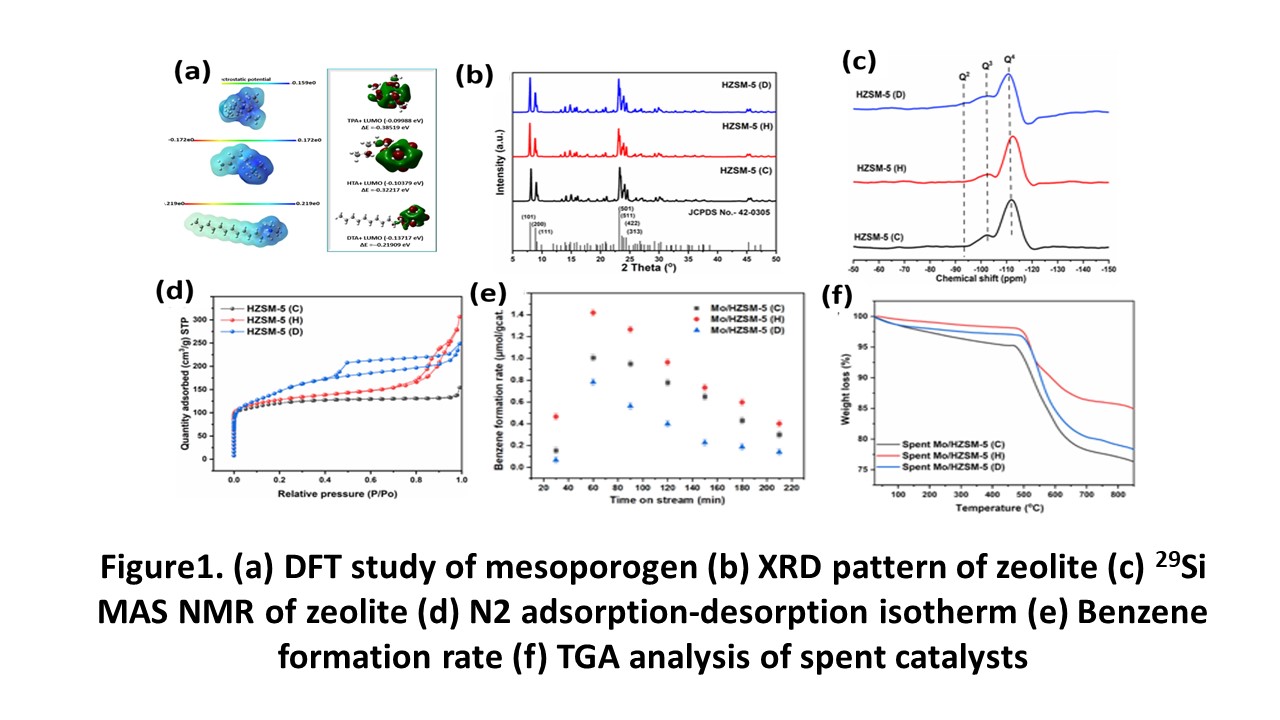2023 AIChE Annual Meeting
(2hy) NON-Oxidative Catalytic Cnversion of Methane into Benzene over Hierarchical Mo/HZSM-5 Catalyst
Introduction. Catalytic transformation of methane into benzene over a bifunctional Mo/HZSM-5 catalyst has great economic potential. However, the reaction suffers serious hurdles due to the blockage in the micropores because of extensive coking during methane dehydroaromatization (MDA) which leads to catalyst deactivation. It necessitates the design of micro/mesoporous ZSM-5, which has the advantages of micro/mesoporous channel and lower carbon deposition because of improved mass transfer. In this study, we report a unique strategy to control the porous structures of ZSM-5 through a dual templating approach, utilizing C6 and C12 -surfactants as porogen. The structural and morphological parameters of the synthesized ZSM-5 & Mo/HZSM-5 were explored in detail & tested for MDA reaction to evaluate the introduction of hierarchical pore.
Experimental/methodology. Hierarchical ZSM-5 having MFI framework is hydrothermally synthesized according to the molar ratio 32TEOS: 1NaAlO2: 8TPAOH:13HTAB/DTAB: 1138H2O in Teflon lined stainless steel autoclave for 2 days at 170 â under static condition. While Mo-impregnated bifunctional Mo/HZSM-5 catalyst was synthesized by applying the wet-impregnation method using heptamolybdate salt as Mo precursor as reported.
Results and discussion. Fig.1a showed that the ELUMO value of HTAB mesoporogen is comparable with TPAOH indicating that HTAB has more affinity to guide the ZSM-5 framework during synthesis. All synthesized HZSM-5 (Fig.1b&c) exhibited diffraction XRD peaks in the 2θ range of 7-9ο and 21-25ο, characteristic of ZSM-5 having MFI topology,29Si MAS analysis showed the peak for tetrahedrally bonded Si(OSi)4 and Si(OSi)3OAl). While (Fig.1d) in addition to the Type I isotherm of microporous ZSM-5(C), HZSM-5 synthesized using HTAB and DTAB showed Type IV isotherm with characteristic hysteresis loop. From the activity the test, it was observed that C6 surfactant-modified hierarchically porous Mo/HZSM-5(H) showed the highest benzene formation rate (1.5 μmol/gcat. s) and longer catalytic stability up to 270 min of reaction as compared to microporous Mo/HZSM-5(C). We ascribed that the difference in MDA activity could be due to the hierarchically interconnected meso/microporous feature of Mo/HZSM-5(H) that precludes secondary reaction of coking from benzene and hence contributes substantial stability towards MDA reaction as observed from TGA profile with less coke generation.
